What is Programmatic SEO and What Can You Do with It?
In this article, I'll explain what programmatic SEO is and give you practical examples of how powerful it can be as part of your SEO and content strategy.
Content creation is a time consuming process and often a blocker for scaling your business. When I'm looking to plan out a new content strategy, the process usually looks something like this:
- Find the keywords that people are searching for
- Cluster those keywords into topics
- Write a content brief for each topic
- List on job on Upwork to find a writer
- Sift through 50+ applications
- Hire 5-10 writers on a trial
- Pick the top 1-2 to train further
- Repeat the process again when writers leave
Don't get me wrong, I’ve had great success building a content machine like that but, for a solo builder, it’s a lot to manage across a growing network of sites.
Even if you're a SaaS or an agency with a team behind you, it's still a lot of work to manage and a bottleneck for growing your organic visibility.
Enter programmatic SEO.
What is programmatic SEO?
Programmatic SEO is a way of generating a large number of blog posts or content on topics people are searching for in Google at scale using a template and a data source. It's a long-tail keyword strategy that maintains quality so that the pages do not look or feel like they were generated programmatically.
I would go as far as to say that programmatic SEO is the most effective way to scale your organic traffic.
It's really not that different to normal SEO. You need to:
- Find topics people are searching for
- Create a page that answers that question
The difference with programmatic is that we can do it at scale by using data to find topics that are repeatable, and can be used to answer the question or query people are searching for.
The keywords tend to be less competitive long-tail terms, and because of the volume of pages you can generate, it amounts to a lot of traffic.
For the type of sites I build, I prefer the term "data sites" because I spend as much time collecting and organising data as I do using programmatic SEO to build a site around it.
You'll probably have seen it in action with local SEO. Sites like TripAdvisor, Expedia, Airbnb, etc use programmatic SEO to generate landing pages for tens of thousands of locations.
Let's say you have a website with 1,000 pages created using programmatic SEO (which is a tiny amount compared to most of my sites).
If you average 50 visits a month per page, that's 50,000 visits a month.
This is pretty realistic too, because the very nature of programmatic SEO means that you end up targeting long tail, low competition keywords.
Data + programmatic SEO = 🔥📈
I get a lot of questions about how to get started with programmatic SEO, so I decided to write this guide.
One of the first questions is usually about how much traffic you can get or if you can rank using data and templates alone.
Here are some of the stats from my portfolio 👀:
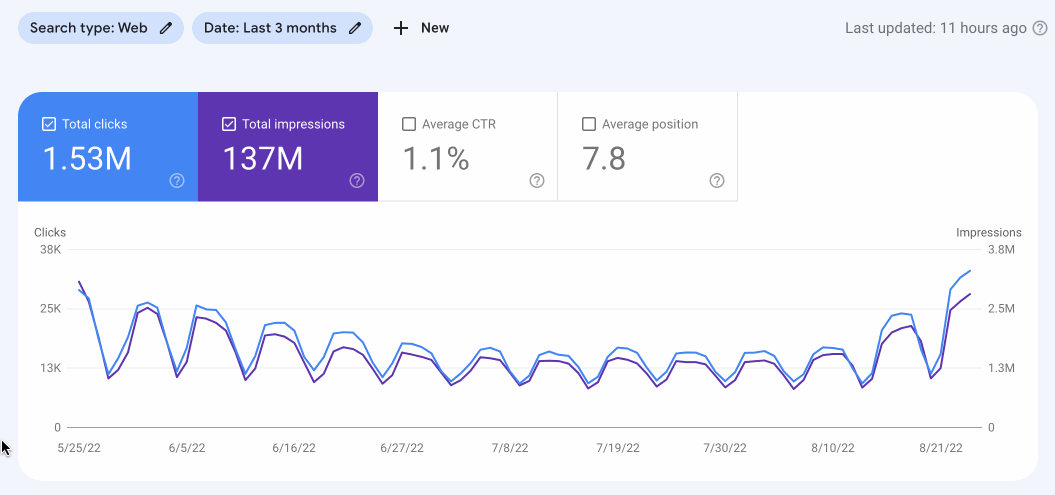
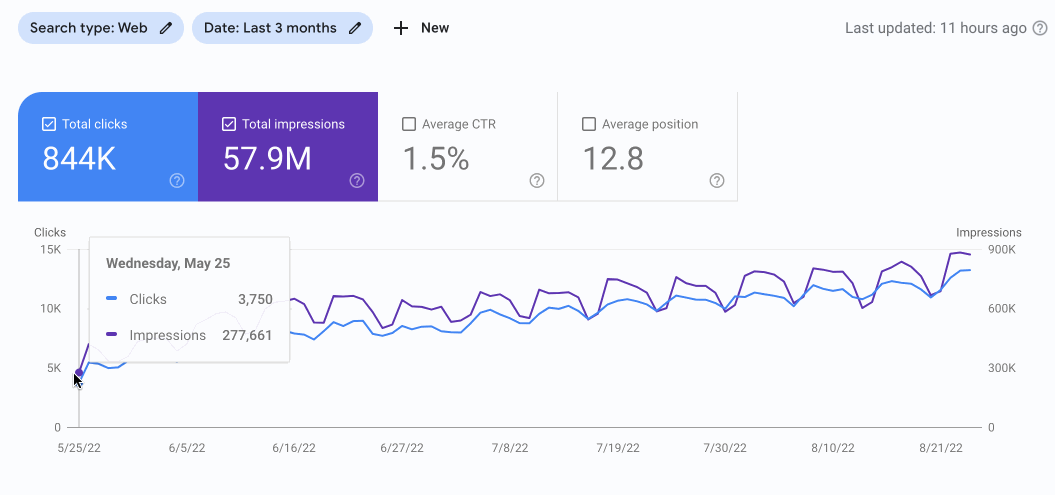
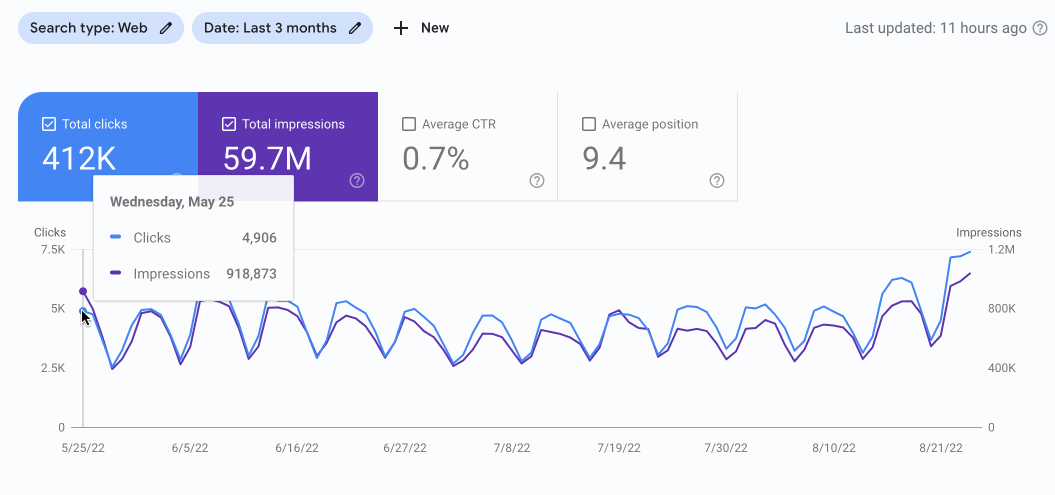
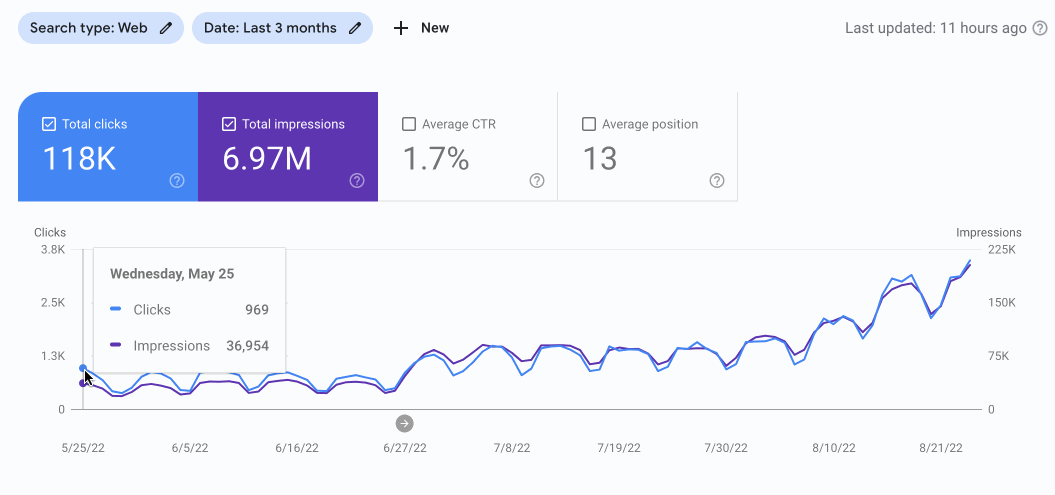
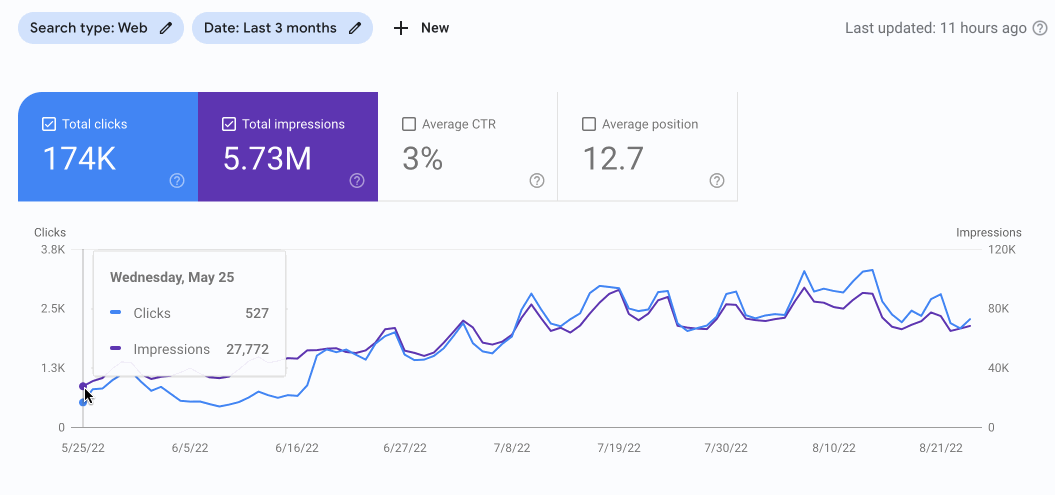
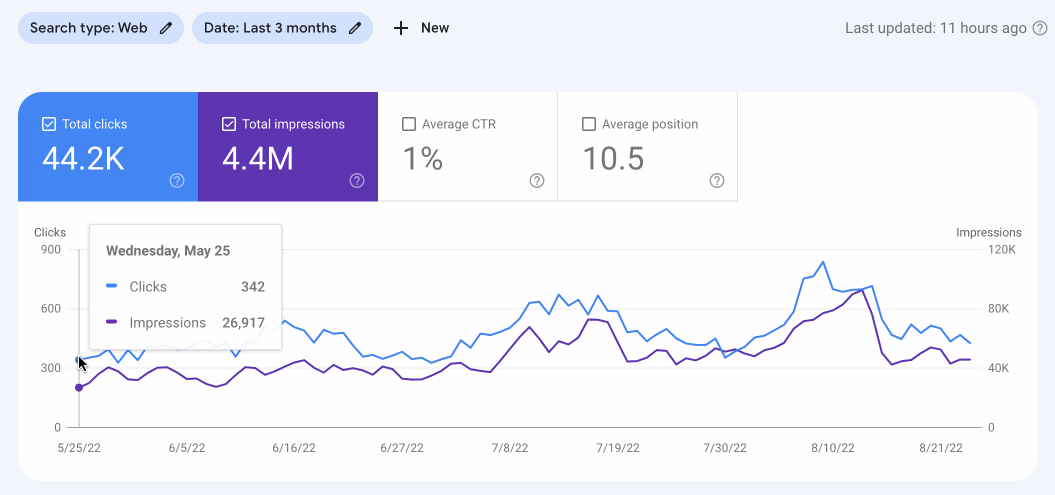
Most of these sites were aged content sites that had been abandoned by the previous owner. I acquired them through cold outreach, and used programmatic SEO to grow them.
Sites 5 and 6 though, were brand new domains registered in May 2021. I built the datasets and sites from scratch, and it took ~1 year to get them to these traffic levels.
How does programmatic SEO work?
- Through the page template, you design and format how you want the generated pages to look and feel.
- Through the database, you collect what information or data points you want to show.
Connect the page template with the database by using an automation program, run the program, and you’re done! You should now have the pages in bulk, and often the number of generated pages equals the number of entries in the database.
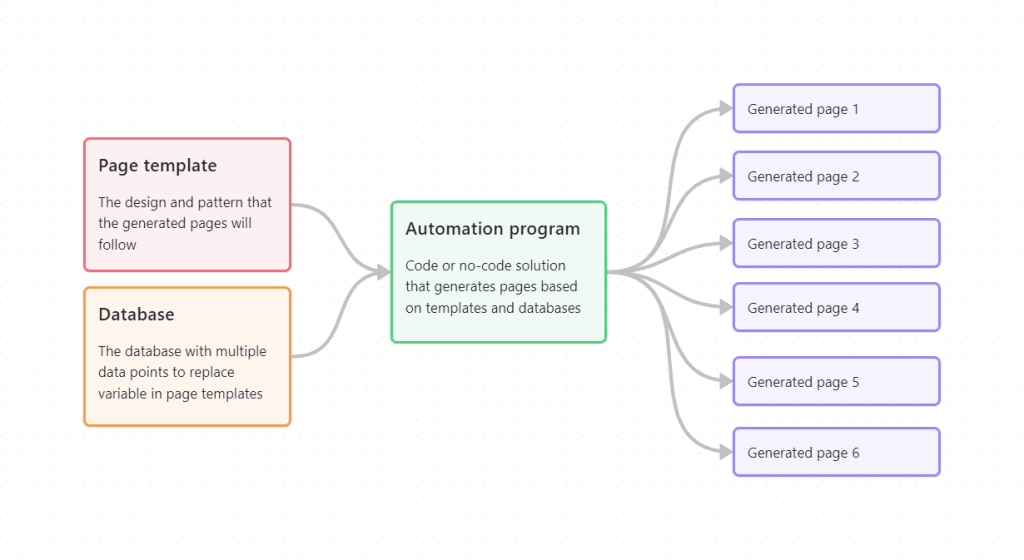
You can design page templates to look like a simple blog post or a polished landing page, and the database can be a simple CSV file or a MySQL instance. It all depends on what you will be using it for.
Well, here are some things that you can do. Let’s see…
What can I do with programmatic SEO?
You can drive tons of highly targeted traffic to your website by using the techniques of programmatic SEO.
If you do programmatic SEO well, the traffic will come. But what you can actually do with that traffic is when things start to get very interesting and profitable.
1. Create similar-styled pages at scale
“Solana Price” is a keyword that Binance is targeting by creating a separate page that has a specific design, as you see in the screenshot below.
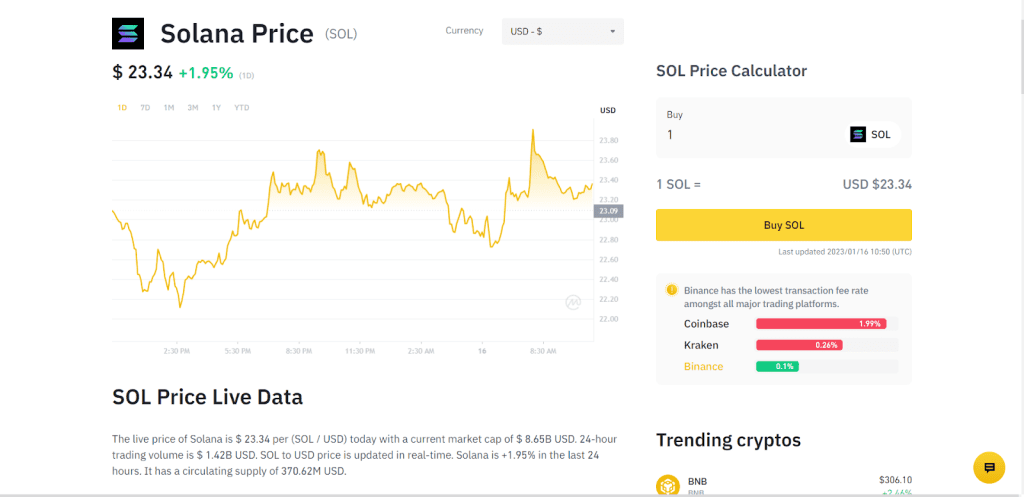
Now, there are 100s of crypto coins like Solana that Binance wants to create separate pages for. So the question is, is there any benefit of keeping the design of all these pages different?
Absolutely not!
Binance should create or rather has created 100s of similar-styled pages for all the other crypto coins like Monero and Neo. They just designed the template once, connected their database of coins with all required data points, and generated a separate page for each coin.
And if you analyze, what benefit did they get from programmatic SEO?
- Scale – as they generated 100s of pages in comparatively less time
- Exposure – as those pages rank and get 1000s of monthly organic traffic
- Revenue – as more people come to the website, there will be more customers
Whether you have a SaaS business or a simple content site, you can use programmatic SEO to create similar-styled pages and drive targeted traffic to your website. For SaaS businesses, you can create comparison and alternative pages; for content sites, you can use pSEO to establish a content hub.
You can use the technique for literally any business.
2. Get more leads
Run a SaaS company, sell a digital product, or have a simple newsletter?
You can use programmatic SEO to put your brand out in front of thousands of people. Create 100s of information pages on your website that your target audience searches for, and you can collect leads for your business once they land on your website.
The best example of this is Failory, which programmatically created 100s of information pages to attract readers who were interested in startups. And grew its newsletter to more than 25,000 readers.

Failory placed CTA banners (like the one you see in the screenshot above) on top of all the programmatically created information pages and earned a massive list of emails by offering useful freebies.
Let me show you one more example…

Another pSEO example is Upsolve which creates informative pages and places an eye-catching CTA banner in the sidebar, as you can see in the screenshot. The keywords that the site targets are transactional, and the CTA is so good that it’s difficult for readers to not click on the “Get Started” button.
I'm using these exact strategies on this site too with the programmatic SEO examples and programmatic SEO datasets pages.
Programmatic SEO can work very well as a lead-generation tool!
3. Generate more revenue
More targeted traffic and more leads on your website ultimately translate to more revenue for your business.
Canva generates more than 100 million organic traffic every month and now let’s do some math here.
Say Canva is able to convert just 0.1% of the incoming 100M traffic. And that comes out to be 100,000. Now, out of 100,000 monthly users, say, 10% of users upgrade to the premium which is around $10 per month. Then it’s $100,000 monthly revenue only from the organic channel programmatic SEO.
And it’s a serious underestimation, by the way.
Let’s take another example of a small content site in the dog niche that monetizes via affiliate promotion. Generally, affiliate marketers create simple affiliate pages like best dog foods for labradoodles which are difficult to rank for new sites.

But the new sites can easily target keywords like can dogs eat brisket and can dogs eat chicken salad and rank for them as well. And as these topics are very similar, there certainly are scopes for using programmatic SEO.
And if an affiliate site gets more targeted visitors, it will ultimately translate to more revenue.
4. Present boring data in a beautiful way
Take a look at both parts of the below image, both showcase the same data (from OECD data). Now, tell me which is easier to take a look at and understand.
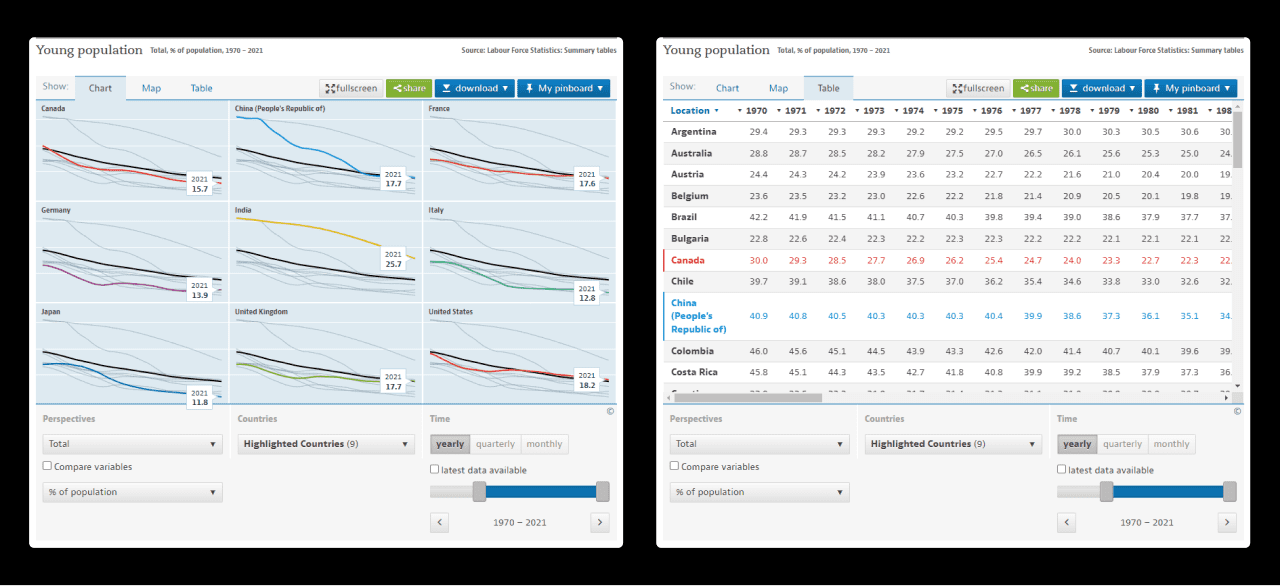
If you’re like most people, you would prefer looking at the second image. Because it looks beautiful and is easier to visualize.
You can also use programmatic SEO to showcase a huge amount of data in a beautiful way by creating multiple pages. And of course, it will also reward you with a lot of traffic.
And that should give you an idea of the possibilities with programmatic SEO.
Programmatic SEO benefits
At this point, the benefits of programmatic SEO should be pretty obvious. Let's quickly recap why this is such a great strategy for scaling traffic.
- Target a lot of long-tail keywords very quickly
- No expensive, ongoing content creation
- Can be done without hiring and training writers
- Much less stress vs editorial SEO
- Creating unique content by combining data (more natural backlinks)
With programmatic SEO, I can spend 2 weeks building a really solid and useful dataset, and then output content around that data using a handful of well written templates.
(and honestly, the last few builds I've outsourced the data collection stage to Upwork)
All up, I spend about a month building programmatic sites and then they become 99% passive. Some auto-update, others I need to run a script once a year to update the data.
Programmatic SEO examples
I've already mentioned a few examples of programmatic SEO in action above and linked to them, but here's another great example of a programmatic SEO site in the real world.
One of my favourites, which mirrors the type of pages I like to create is the inflation calculator at In2013Dollars.com.
Using inflation data provided by the BLS, the site is able to produce content on the inflation rates and changes from 1635 to the latest year.
So, if you compare the value of $100 in 2015 to $100 in 2022, each comparison like this has it's own URL:
https://www.in2013dollars.com/us/inflation/2015?amount=100
The site takes the start year, end year, and amount, from the URL and calculates the data from the database of CPI values by month and year.
The result is a ~1,900 word template that includes content, tables, charts and downloadable data on a host of areas:
- Buying power
- Inflation by city
- Inflation by country (comparing US to other countries like the UK)
- Inflation by spending category
- Details on calculation and formula
- Alternate measurements
- Comparing to S&P 500
It performs pretty well in Google, too!

If I were recreating this site (which I may or may not have done 🤐) I would:
- Write a PHP or Python scraper to download the data from here
- Set it up on a cron job to run every month and update the db
- Write a CPI class that can calculate the data for a given start year, end year, and amount
Once you you have the data in that format, you can write a template that outputs the content. More on that later.
Finding good data to use
I'll cover this in another post in much more detail, but the main places I source my data are:
- Data.gov - lots of great data sources made public by the US government
- Scraping it - I find interesting sites all the time with valueable data to scrape
- GitHub - there are some great datasets on GitHub that are open source and free to use (example)
To trick is to learn what data works the best for programmatic SEO. You'll figure that out over time through trial and error. I've had success with very simple data, and also with very complex data. Who knows what's gonna rank?!
Programmatic SEO is still mostly just SEO
For SEO, I keep it very simple and let the long-tail keywords do their thing. You're programmatically creating a lot of pages, but it's still just basic SEO.
- Keyword focused H1, title + description in the controller
- Breadcrumb navigation
- Internal linking (in the article and also sidebar widgets)
- Basic schema markup
- XML sitemap (or index of sitemaps) to submit to GSC
- Redis to cache database queries
- Cloudflare Page Rules to cache the front end
This generates very simple, fast-loading pages that are easy to crawl and index. Good SEO is rarely complicated.
Writing helpful page templates
The second most important part of programmatic SEO after getting the data is writing killer templates.
This is where you can really stand out from the crowd and create something that's useful and unique. Most sites don't put enough effort into this part and it's where you can do better to outrank them.
There may be some people that see programmatic SEO as spammy or call them doorway pages. I don't agree!
The goal for me isn't just 100,000 pages. It's to provide value on those 100k pages.
I hate to continue this trend of boringly simple advice, but it is quite straightforward:
- At least 700-1000 words of content (with headings, lists etc)
- Conditional content based on the specific page
- HTML tables, maps or interactive data charts
- Internal links to related pages
I always try to make my sites better than the competition. More detailed, more data, easier to use, the ability to download or export the data.
Programmatic SEO is a tool, but you can and should still build top quality sites with it.
Programmatic SEO FAQs
1. Can I implement programmatic SEO on my existing website?
Yes, 100%.
In fact, implementing the techniques of programmatic SEO on an existing website works better as compared to a fresh domain because Google and other search engines already trust the site’s content.
And I am talking about both – a business site and a simple content site.
2. Would it be possible to do programmatic SEO on WordPress?
Yes, it’s possible to do programmatic SEO on WordPress. There are plugins and SaaS tools that make this possible.
And not just on WordPress, you can programmatically generate pages on almost all platforms – be it Webflow, Wix, Duda, and even on custom-coded sites.
3. Does Google consider programmatic sites spam?
No, Google does not consider programmatic sites as spam. In spam policies, Google has clarified that they don’t consider all automatically generated content as spam.
However, if the programmatic pages are of very low quality, or you are just showing any scraped data without adding any value, Google might consider it spam.
Final words
If you manage to create content that is useful for the users, Google or any other search engines aren't concerned about the method you have used to create content – you’re good to go.
Furthermore, remember that the “technical parts” in programmatic SEO are not the most important parts; it’s the “non-technical parts” (like choosing keywords, preparing datasets, outlining page templates, etc.) that are critical for success.
And that's it! If you made it this far down the page, you're pretty much obligated to purchase my programmatic SEO course and join over 1,000 people scaling online traffic for themselves or their clients. 😉